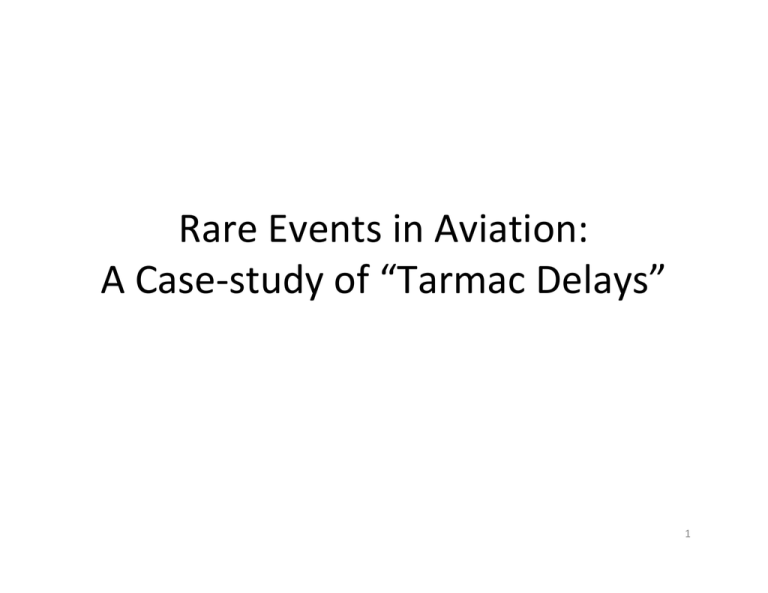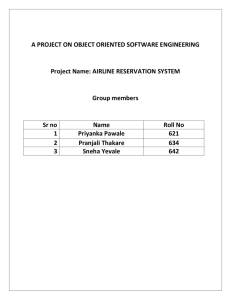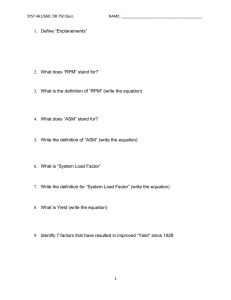Rare Events in Aviation: A Case‐study of “Tarmac Delays” 1
advertisement

Rare Events in Aviation: A Case‐study of “Tarmac Delays” 1 Tarmac Delay • Holding passengers in aircraft on Tarmac for > 2 hrs without access to food/water/services • Holding passengers in aircraft on Tarmac for > 3 hours without option for deplaning History • 1999: Northwest Airlines stranded passengers on tarmac at Detroit. – No food, water and bathroom facilities. • • 2000: 1st Passenger Bill of Rights introduced but failed to muster enough votes for passage. 2001: Senator John McCain proposed the second Airlines Passenger Bill of Rights, but due to strong airline lobbying the legislation never passed. – Airlines pledged to undergo internal reviews of their customer service policies • • 2006: American Airlines (AAL 1348) strands passenger stranding in Austin for 9 hours 2007: St. Valentine’s Day Ice Storm – Jet Blue strands passengers at JFK – http://www.bing.com/videos/watch/video/jetblue‐tries‐to‐lose‐its‐red‐ face/6igxg8w • Delta Flight 6499 June 25, 2007 – http://www.youtube.com/watch?v=R06dAgpmmbg&feature=related • 2009: Passenger Bill of Rights Passes 3 Consumer Activist • • • • • FlyersRights.org was formed to support in 2006 to give flying public a legal voice and recourse California Realtor, Kate Hanni, was stranded with her husband and two children for 9 hours on the tarmac in Austin, Texas. 25,000 members largest non‐profit consumer organization in the United States representing airline passengers. http://www.youtube.com/watch ?v=5gE4a4aHJa4 4 Passenger Bill of Rights • On Dec 21st, 2009, Department of Transportation (DOT) announced Rule – prohibits U.S. aircraft on domestic routes from remaining on a Tarmac for more than three hours with travelers aboard • Rule goes into effect April 29,2010 – JetBlue Airways Corporation (“JetBlue”) and Delta Air Lines, Inc., (“Delta”) request exemption during “Bay Runway” 13R/31L construction at JFK 5 Contents of Rule (1/2) • Rule applies to all U.S. passenger airlines operating flights with more than 30 seats • Airlines will be not allowed to schedule chronically delayed flights. – “Flights that operate at least 10 times a month are only chronically late if they arrive at their destination more than 30 minutes after their scheduled arrival time more than half the time.” Federal Report, 2009. – “And the delays must occur for more than four straight months before the airline risks a fine” Federal Report, 2009. 6 Contents of Rule (2/2) • Requirements for Airlines: 1. Adopt and publish contingency plans for lengthy tarmac delay their websites. 1. 2. Provide food and water for Tarmac Delays > 2 hours Passengers have rights to de‐plane after 3 hours (with some limitations) 2. Respond to consumer problems 1. Airlines must designate an employee to monitor the effects of flight delays and cancellations 3. Declare the operation of flights that remain chronically delayed to be an unfair and deceptive practice and an unfair method of competition 7 Contents of Rule (2/3) • Requirements for Airlines (cont/d) 1. Airlines cannot retroactively apply changes to their contracts of carriage 2. Publish delay data on their websites. 3. Adopt a customer service plan and self‐audit adherence to it 8 Tarmac Delay Statistics (PHL) Tarmac Delay Grouped by Minutes Years 0‐59m 60‐ 119m 2005 122278 3620 456 69 6 126429 2006 105045 2833 339 85 10 108312 2007 99729 3729 445 122 31 2008 97372 2770 248 81 27 2009 75554 2644 329 54 6 499,978 15,596 1,817 411 80 TOTAL 120‐ 179m 180‐ 239m 240‐ 299m 300‐ 359m 360‐ 419m 4 TOTAL 104060 1 100499 78587 4 1 517,887 Total Flights with Tarmac Delay >= 2 hours 2313 Percentage of Flights with Tarmac Delay >= 2 hours 0.44% 9 Tarmac Delays Statistics by Year (PHL) Percentage of Flights per Year 78587, 15% 126429, 25% 100499, 19% 104060, 20% 2005 2006 2007 108312, 21% 2008 2009 10 Tarmac Delay Statistics by Month (PHL) Percentage of Fligths (2+ TD) Year ‐ TD 2005 Month 2 3 1 0.20 0.07 2 0.40 0.02 3 0.19 0.01 4 0.06 5 0.08 6 1.08 0.13 7 1.22 0.13 8 0.37 0.09 9 0.11 0.05 10 0.01 0.01 11 0.13 0.13 12 0.43 0.02 Average per hour/year 0.36 0.07 Annual Percentage 0.44 4 0.04 0.01 0.01 0.02 2006 2 3 0.04 0.02 0.07 0.02 0.27 0.04 1.40 0.33 0.65 0.15 0.45 0.04 0.55 0.31 0.08 0.02 0.20 0.03 0.07 0.34 0.12 0.49 4 0.02 0.01 0.07 0.01 0.03 2007 2 0.06 0.20 0.25 0.28 0.24 1.46 0.64 0.48 0.42 0.98 0.04 0.04 0.42 3 4 5 0.24 0.24 0.04 0.05 0.01 0.07 0.38 0.11 0.01 0.14 0.09 0.33 0.13 0.01 0.18 0.09 0.02 0.72 2008 2 0.01 0.47 0.02 0.19 0.07 0.68 0.60 0.38 0.15 0.12 0.04 0.20 0.24 3 4 6 0.35 0.03 0.01 0.09 0.01 0.36 0.26 0.01 0.08 0.04 0.01 0.01 0.02 0.12 0.08 0.01 0.45 2009 2 0.64 0.28 0.12 0.18 0.17 1.23 0.83 0.63 3 0.05 0.18 0.01 0.09 0.31 0.07 0.04 0.51 0.11 0.07 0.70 June, consistently worst month. * TD: Tarmac Delay 4 11 Tarmac delays by Airline (PHL) 50 2% 72 102 3% 4% 110 5% Tarmac Delays by Airlines Jan 2005 ‐ Oct 2009 118 5% US Airways Inc. Southwest Airlines Co. United Air Lines Inc. American Airlines Inc. 192 8% 1123 49% Northwest Airlines Inc. Delta Air Lines Inc. AirTran Airways Corporation 201 9% Continental Air Lines Inc. 345 15% Others 12 Tarmac Delays by Destination ‐ PHL Tarmac Delays by Destination Jan 2005‐ Oct 2009 ORD ATL 13.58% 5.27% BOS DFW 4.67% 43.84% 4.41% MCO DEN LAS 4.15% 3.93% 3.63% 3.11% 3.16% 3.46% 3.29% 3.50% PIT DTW LAX PHX MDW Others ( Less than 3%) 13 Conclusions I • Tarmac Delays are in‐the‐tails‐of‐the distribution – Complex phenomena – Infrequent situations – Scenarios that fall through the cracks 2 hrs 3 hrs Taxi‐out Delays 14 Stakeholders Consumer Watchdogs / Media Congress DOT/FAA Public Relations Airline PR AOC “Super” Center Airspace Center Airspace Center Airspace Center Airspace Center Airspace Center Airspace Center Airspace ATC Liasson Airline Airline Airline Dispatcher Airline Dispatcher Airline Dispatcher Dispatcher Dispatcher Station Manager Ramp Controller Airport Managemen t Ground Controller TSA Immigration 15 Stakeholder (critical only) Flight-crew Roles and Responsibilities (and Authority to Mitigate Tarmac Delays) Operate the flight. Have final say on flight readiness and progress. Rely on dispatch to file flightplans, approve fuel, authorize flight, get gate assignment. Rely on air traffic control to provide clearance. Has no authority or mechanism to avoid tarmac delays. Airline Dispatcher Manages flights from gate-to-gate. Has full legal authority for operation of each flight. Has full legal responsibility for flight (e.g. violation of immigration laws, etc). Has authority, along with Supervisor, to prioritize airline flights. Airline Dispatcher Coordinates airline dispatch requests – ATC Liasson with ATSCCC Traffic Flow Programs. Has authority to negotiate on behalf of tarmac delay flights, but may require cooperation of ATSCCC and other airlines. Airline Dispatch/AOC Supervisor Gaps Ability to Monitor Individual Flight Status on the Surface Flight-crew know the status of their Fully aware of tarmac delay status flight. of their flight. Does not have full knowledge of scope of TFM initiatives or status of airline network operations. Relies on contact with Ramp/Ground Controller and Dispatch. Detailed trajectory information of flight Does not have full knowledge of while airborne. No information of scope of TFM initiatives or status of position of flight on airport surface. airline network operations. Relies Voice and data communication with on contact with ATC Liasson. (In flight-crew and Station Manager. some circumstances) can be Dispatch automation provides OOOI overloaded and must work highest items first. Can status of flight (gate-out, off, on, gate- priority in). (temporarily) lose track of tarmac delay flights. See Airline Dispatcher, plus automation Is not alerted of tarmac delay status to support TMI “programs” (e.g. Flight of each flight. Does not have Schedule Monitor) detailed knowledge of the status of individual flights. Does have access to TFM initiative data. Is not automatically alerted about tarmac delay flights. See Airline Dispatcher, plus automation Is not alerted to tarmac delay status to support TMI “programs” (e.g. Flight of each flight. Schedule Monitor) Oversees all airline dispatch operations. – Monitoring “big picture” and airline trends. Not focused on individual flights. Has authority to prioritize airline flights. Airline Station Coordinates ground support for all No automation support. Has eyes and Is not alerted to tarmac delay status Manager (and flights at gates. No explicit ears on the airport surface and contact of each flight. Gate and Ground responsibilities for flights that have with dispatch. Personnel) pushed-back or not gated-in. Has no authority to mitigate tarmac delayed flights. Stakeholder (critical only) Roles and Responsibilities (and Authority to Mitigate Tarmac Delays) Ramp Controller Coordinates flights push-back/gate-in and ramp trajectories. No authority with regard to mitigating tarmac delays. Ground Coordinates flight trajectories on Controller airport taxiway system. No authority with regard to mitigating tarmac delays. ATSCCC NOM Provides oversight of Traffic Management Initiatives at the ATSCCC. Has more of a NAS-wide responsibility than the TFMU (see below). Responsibility for flights involved a TMI “program.” Has authority to intercede on behalf of airline in negotiation with other airlines and TFMU. ATSCCC TFMU Provides oversight of Traffic Management Initiatives at the ATSCCC. Responsibility for flights involved a TMI “program.” Has authority to prioritize flights within the scope of rules of TMI’s. Airport Manage and operate the airport as a Management/Ope “public utility.” Coordinate outsourced rations operations. Responsibility for emergency and abnormal operations. Has no authority with regard to tarmac delays. Under new DOT rule has some responsibility for providing resources and infrastructure to deplane passengers. Can support airlines, but not intervene in airlines operations. Ability to Monitor Individual Flight Status on the Surface Gaps Has flight strips for all flights on Flight strips provide indication. taxiways. In good visibility has eyes out the tower cab. Has flight strips for all flights on Flight strips provide indication. taxiways. In good visibility has eyes out the tower cab. Has detailed information of all flights Is not alerted to tarmac delay in a TMI “program” status of each flight. Has knowledge of excessive departure queuing at airports. Has detailed information of all flights Is not alerted to tarmac delay in a TMI “program.” May only be status of each flight. Has assigned a sub-set of airports. knowledge of excessive departure queuing at airports. No automation support. Has eyes and Is not alerted to tarmac delay ears on the airport surface and contact status of each flight. May have with dispatch. knowledge of excessive departure queuing at airports. 17 Authority vs. Information • Ramp/Ground Controller have information (but not authority) • TFMU has authority (but not information) • Dispatcher (has some information, but no authority) • Dispatch Liasson/Supervisor has authority (but no information) 18 Question • Given: – Phenomenon in‐tails‐of‐distribution • Complex, infrequent, variability – Authority/Information gap • Will Rule solve the problem? 19 Solution: Tool (for Information to those in Authority) 20 “Lost Flight/Tarmac Delay” Tool Target Users: • NOM at ATSCC • ATC Liasson Airline Dispatchers/AOC “Super” • Station Manager • Airport Management Operator Task List: 1. Know of all flights on tarmac longer than <threshold time> 2. Identify flights above caution/warning thresholds 3. Check on flight status (e.g. EDCT, Mx, …..) 4. Based on 3, take mitigation steps: 1. 2. If TMI then …..? If Airline, then contact airline 1. 2. 3. 3. Look up airline contact info Send message/make call Add agenda item to 2hr telecon If unable 2, then contact airport 21 “Lost Flight” Tool Reqs Objective: Provide decision support for mitigation of “Lost Flights” and “Tarmac Delays” Functional Requirements: 1. Detect all flights on tarmac in excess of <time threshold> 2. Provide status on these flights 3. Provide contextual information (airport status, TMI status, …) 4. Alert all flights on tarmac approaching <caution threshold> and <time threshold> 5. Provide operator with necessary contact information to initiate mitigation strategies Performance Requirements 1. Accuracy 2. 5 minute update rate Technology Requirements 1. Web‐based (for multiple location access) 22 Input/Output & Data Sources Surface Track Data ARINC Flight Status Updates Gate‐In, Gate‐ Out, Wheels‐ Off, Wheels‐On Data processing Airline Contact Info Station Manager TMI/ Fly.faa.gov CDMNet GUI Geopolitical Airport Surface Images Flight Status Updates (ADL) Dispatch/AOC ATSCC/TFMU Flight Status Updates 23 2 National Airspace System – Airport Tarmac Delay “hot‐ spots” 1 Delayed flights on Tarmac (departures or arrivals) 3 Information Panel (e.g. Airport Status Information ‐ faaInfo.gov) 24 SCENARIO: Flight B6345, Sch. Dep GMT 13:25, Cur. GMT 15:15, TARMAC DELAY: 1:50:00 25 SCENARIO: Flight B6345, Sch. Dep GMT 13:25, Cur. GMT 15:15, TARMAC DELAY: 1:50:00 Turns orange after 2 hours (note: not a tarmac delay until 3 hours) 26 Location of flights Red = Lost Flight (> 3 hrs) Orange = Potential Lost Flight (> 2hrs) Green = Delayed flights Data Block: •Flight Number •Arrival/Departure •Status 27 SCENARIO: Delayed Flights 07‐23‐2008 GMT 22:30:00 2 1 Delayed flights GMT: 22:30 JFK Airport Red: Lost Flights Orange: Potential Tarmac Delays Green: Delayed Flights 3 Flight B6123 Tarmac Time: 4:25 28 SCENARIO: Critical Time at JFK GMT: 23:45:00 29 30





